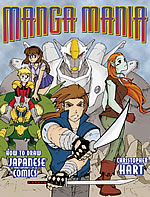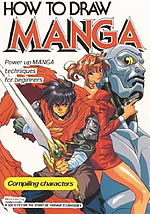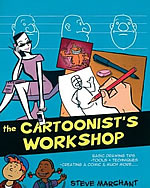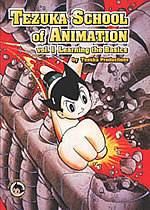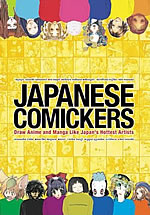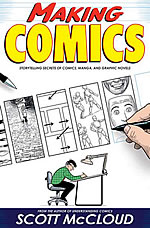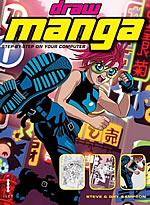Manga:
How To Draw Manga
"Hello, can I speak to Paul Gravett? I was given your name because we are looking for someone to help us produce a ‘How To’ book about Mango Art."
"I’m sorry, ‘Mango Art’?!"
My heart sank as I heard this phone enquiry from one of the numerous overeager but underinformed publishers who are clambering aboard the manga bandwagon. These days, it seems like every publisher of art, design or instructional books feels they have to add a title to their list on the hot new youth craze for drawing Japanese comics and animation. One problem is that these opportunist companies frequently know next to nothing about the medium and to cash in, they are not always that fussed about who they find to throw something together.
It’s no wonder that manga manuals are proliferating, when the Manga Mania series by the unstoppable Christopher Hart is by far the biggest-selling ‘How To’ artbooks currently from American publisher Watson-Guptill, while the ever-expanding How To Draw Manga volumes from Graphic-sha in Tokyo have shifted more than a million copies worldwide in up to ten different languages. There is now such a dizzying variety to choose from, all claiming to give even an absolute beginner all the secrets to create manga, that it can become confusing, overwhelming, even discouraging.
So, apart from ‘How To’ books, how do newcomers in Japan get the hang of manga? Some promising talents get spotted by successful, established mangaka (manga artists) or by their agents, perhaps by entering a magazine competition or creating a doujinshi or self-published fanzine. If they prove good enough, they might be taken on to be assistants, working under the supervision of the sensei or master artist. The real rewards are that you are able to learn from hands-on experience and training on the job for publication.
To any aspiring manga novice in the West, this sounds like a dream. The problems with the assistant system, however, are that it can be exploitative and become a dead end. Assistants often receive very modest payment, and work long hours in cramped conditions with little or no job security. If you become especially proficient in one aspect, say in drawing skies or machinery, you may find yourself trapped by this specialised skill and unable to change.
Another option in Japan is to take courses by correspondence, online or at one of the established manga schools. For example, the hugely successful Rumiko Takahashi always credited her valuable studies while she was enrolled at the Gekiga Sonjuku, one of the most demanding comics colleges run by Kazuo Koike, veteran author of such classics as Lone Wolf And Cub.
But short of moving to Japan, most young Western hopefuls have to rely on the manga manuals available over here. Choosing which ones are right for you will depend on your level of drawing ability and on your goals. If you’re starting out and all you want to be able to draw are some pin-up illustrations of cute girls, he-man heroes, mecha robots and monsters, then some of the rudimentary guides may suffice. Christopher Hart’s Manga Mania and its numerous sequels were the first to capture the kids’ market, partly because they were simple and widely available. Hart’s books may be fine for youngsters, but several British manga artists and tutors I consulted insisted that there are much better books now to get you started, while one told me he advises his students to avoid Hart’s titles like the plague!
More creators in the West, like Lea Hernandez, Ben Krefta, Ashe Raven and May Li, are putting together manga manuals. The end products are variable, and some are little more than the usual basic ‘How to draw comics’ books given a manga spin and concerned solely with achieving the so-called ‘manga style’ for faces, bodies, and costumes. Still, it would be harsh to condemn them all, just because they are devised by non-Japanese artists. Some of these authors are perhaps better teachers than they are illustrators, and the best produce informative demonstrations of every step in their processes. Also, the fact that their finished images are not always of the highest standard may encourage certain pupils lacking in confidence to think, ‘Hey, I could do that too!’. Sometimes dazzlingly polished artistry can seem so unattainable, especially when a drawing suddenly jumps from a few loosely pencilled circles and shapes to a spectacular masterpiece, revealing none of the stages in-between.
As a general rule, however, if you’re serious about studying manga, it makes sense to go to the source, the Japanese artists themselves. Graphic-sha were the first publishers in Japan to release manga manuals explaining the actual techniques used by mangaka. Translated into English, there are now nearly 40 volumes in their How To Draw Manga collection, joined this Spring by a new compact series called Ultimate Manga Lessons. The HTDM series covers everything from perspective, robots, samurai and guns to ‘super-deformed’ anatomy and sexy sportswear. So where do you begin?
The acclaimed graphic novelist and manga teacher Al Davison thinks that "Both the anatomy and clothing volumes have excellent art and are very well designed. My students refer to them regularly." Experienced comics tutor Steve Marchant, author of The Cartoonist’s Workshop (Collins), also praises the HTDM books but has some reservations. "Where they fall down for Westerners is their focus on certain tools and materials that are not readily available here, chiefly their use of screen-tones. A lot of people get put off when they think that they’ll have to fork out for expensive and hard-to-find materials. However, these books do emphasise a competency with basic drawing skills, and put methods across in a clear and simple way, so they’re the ones I recommend."
It’s worth remembering that splashing out on all those fancy, pricey Japanese products, such as Copic pens and Deleter tone sheets, won’t guarantee to improve your artwork. Besides you can now choose from similar products from Letraset, Stabilo and others. Their ranges may not be so extensive yet, but they are more affordable and available. To create the tonal effects in manga, more people are now switching to computer software, such as the Computones system outlined in two new HTDM volumes this year. Other fine Japanese guides are also coming out in English editions, including a series by the Tezuka Animation Studio from Digital Manga and the inspiring showcases Japanese Comickers and Comic Artists-Asia from Harper Design International.
UK artist Dock, aka Hayden Scott-Baron, a member of the Sweatdrop collective, suggests, "The best HTDM books seem to be those that give you information that you can apply to your artwork. Most people already have some preference in style or subject, so when a book shows ways that they can apply their tastes and develop them with advice, then it’s pretty effective for any reader, regardless of skill level. A few of these books waste too many pages on semi-naked girls, but other books are really good, such as HTDM Volume 3 on Compiling Techniques, which breaks down how to construct a comic."
And that is perhaps the toughest lesson to learn, how to write as well as draw manga. Amazingly, the subject of ‘creating stories’ doesn’t show up in the HTDM line until Volume 39. It’s all very well acquiring all the illustrative tricks, but manga are meant to be stories. Few of the manuals go far enough to explain the distinctive Japanese pacing, panel and page layouts and other structural and storytelling techniques that are essential to this narrative medium. Hopefully, more attention will be paid to teaching visual and verbal narrative in future. Meantime, you can pick up a lot from your favourite manga graphic novels by looking closely at how creators communicate their stories. After all, there’s no better way to learn than by copying.
One of the most practical and detailed guides on how to draw manga and comics of all kinds is the latest from Undertsanding Comics guru Scott McCloud, called simply Making Comics, in which he shows you every step clearly using the comic strip format itself.
BOOK REVIEW EXTRA:
Draw Manga Step-By-Step on Your Computer
by Steve & Ghy Sampson
Ilex
£9.99
One of the most proactive, prolific British publishers in this proliferating How To field is Ilex Press and this latest manual by a Brighton-based team is basically a 275-stage tutorial on PhotoShop techniques to transform a sample ready-made line drawing into a lushly coloured, layered, three-dimensional illustration. Undoubtedly useful and applicable for enthusiasts with plenty of time and patience to noodle away on their computers, I do wonder if the end result here - essentially the cover - truly justifies such an elaborate amount of minute tweakings? With this many choices and decisions, computer-colouring might seem to slow down the process instead of speeding it up. And yet again, this is another book that does not really deliver the promise of its title, as it is much more about cool colouring effects and single pin-ups than sound drawing tips and hardest of all, real panel-to-panel, page-to-page storytelling.
Comic Artists Asia
by Rika Sugiyama
Harper Design International
$24.95
Let’s be blunt: there are way too many ‘How to draw manga’ books being churned out these days, a good many by less than brilliant Western imitators. This book, on the other hand, spotlights genuine manga/manhwa/manhua artists, a dozen from Japan, Korea and Hong Kong, showing you their fabulous colour artworks and explaining all the technques they use to achieve them. Inspiring and enlightening, this and the companion volume Japanese Comickers are in a class of their own.
The original version of this article appeared in 2005 in the pages of Neo, the UK magazine of Manga, Anime, Asian Films, Games & more.













